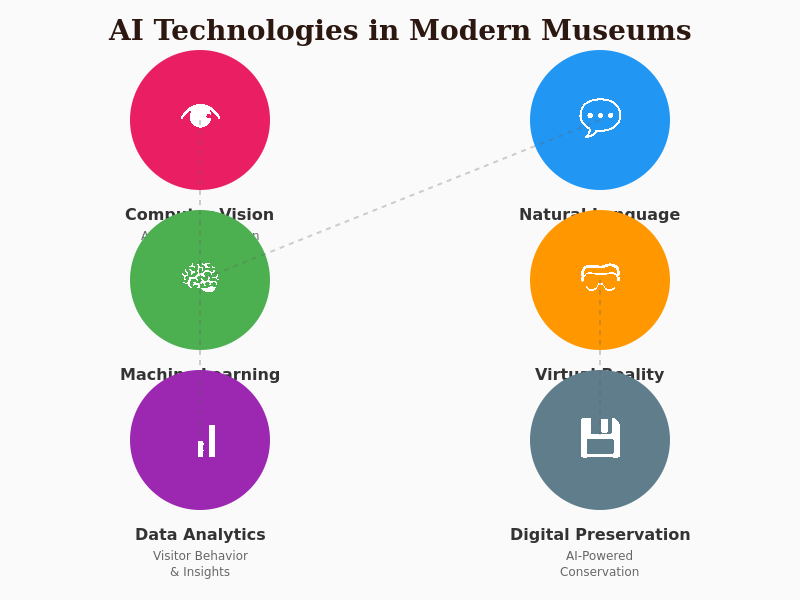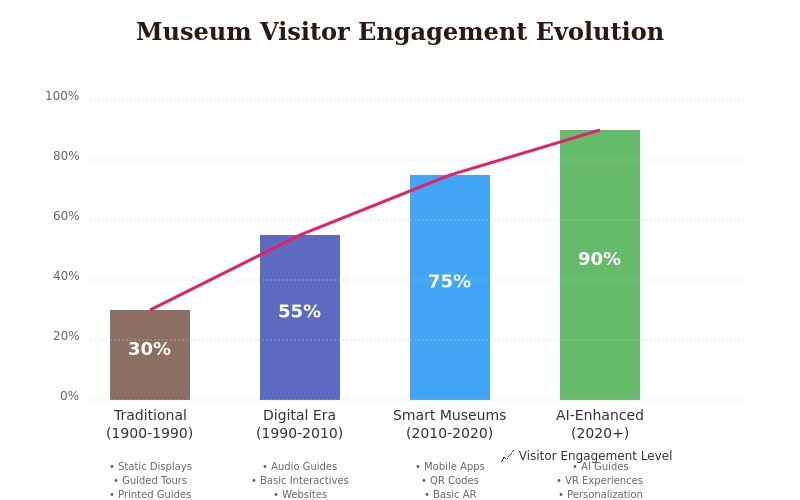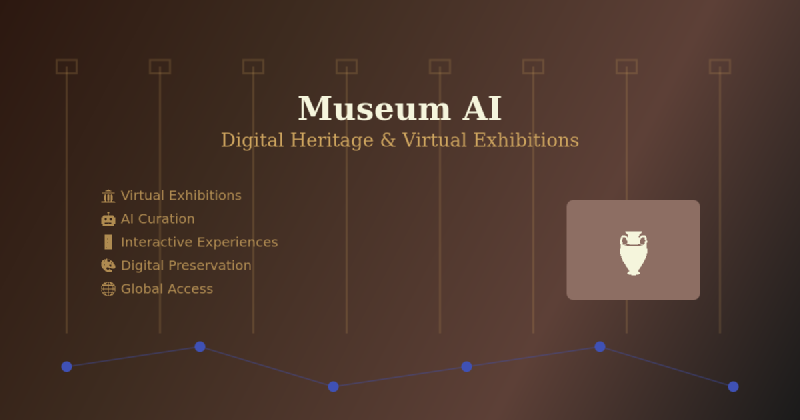The intersection of artificial intelligence and cultural heritage has given birth to a revolutionary transformation in how museums operate, preserve artifacts, and engage with audiences worldwide. Museum AI represents a paradigm shift that transcends traditional boundaries between physical and digital spaces, creating unprecedented opportunities for cultural institutions to preserve, interpret, and share human heritage with global audiences through innovative technological solutions that were unimaginable just a decade ago.
Explore the latest AI innovations transforming cultural institutions and heritage preservation through cutting-edge technological applications. The integration of artificial intelligence into museum operations has fundamentally altered the landscape of cultural preservation, enabling institutions to digitize vast collections, create immersive virtual experiences, and provide personalized educational content that adapts to individual visitor preferences and learning styles.
The Evolution of Museum Technology
The transformation of museums from static repositories of artifacts to dynamic, interactive cultural centers has been accelerated by the adoption of artificial intelligence technologies that enhance every aspect of museum operations. Traditional museums relied primarily on physical displays, printed materials, and guided tours to communicate with visitors, but the digital revolution has introduced sophisticated AI systems that can analyze visitor behavior, personalize experiences, and create engaging multimedia presentations that bring historical narratives to life in ways previously impossible.
Modern museums are embracing AI-powered solutions that range from intelligent chatbots capable of answering complex historical questions to advanced computer vision systems that can automatically catalog and analyze artifacts based on visual characteristics. These technological advancements have enabled museums to overcome traditional limitations related to space, accessibility, and resource constraints while simultaneously expanding their reach to global audiences through virtual platforms and digital interfaces.
The COVID-19 pandemic further accelerated the adoption of digital technologies in museums, forcing institutions to rapidly develop virtual exhibition platforms and remote engagement strategies that rely heavily on AI-powered content delivery systems. This forced evolution has revealed the immense potential of artificial intelligence to democratize access to cultural heritage while maintaining the educational and inspirational qualities that make museum experiences meaningful and transformative.
AI-Powered Digital Preservation
One of the most significant contributions of artificial intelligence to museum operations lies in the realm of digital preservation, where AI systems are revolutionizing how cultural artifacts are documented, analyzed, and maintained for future generations. Advanced machine learning algorithms can now process thousands of high-resolution images to create detailed 3D models of artifacts, enabling researchers and conservators to study objects without physical handling while preserving minute details that might be lost through traditional documentation methods.
Computer vision technology has enabled museums to automatically identify and classify artifacts based on visual characteristics, materials, and stylistic elements, significantly reducing the time and resources required for catalog maintenance and collection management. These AI systems can detect patterns and connections across vast collections that human researchers might overlook, leading to new insights about cultural traditions, artistic influences, and historical connections that enrich our understanding of human heritage.
Experience advanced AI capabilities with Claude for sophisticated analysis and interpretation of complex cultural data sets that require nuanced understanding and contextual awareness. The application of natural language processing to historical documents and archival materials has enabled museums to create searchable databases of textual content, making rare manuscripts, letters, and documents accessible to researchers worldwide while preserving the original materials from deterioration caused by frequent handling.
Virtual Exhibition Innovation
The development of virtual exhibition technology represents one of the most visible applications of AI in modern museums, transforming how cultural institutions present their collections and engage with diverse audiences across geographical and temporal boundaries. AI-powered virtual reality systems can recreate historical environments with stunning accuracy, allowing visitors to walk through ancient cities, explore archaeological sites, or experience historical events as if they were present during those moments in time.
Machine learning algorithms analyze visitor preferences, browsing patterns, and engagement metrics to create personalized virtual exhibition experiences that adapt content presentation, narrative flow, and interactive elements based on individual interests and learning styles. This personalization ensures that each visitor receives a unique and meaningful experience that resonates with their specific cultural background, educational level, and personal interests while maintaining the scholarly integrity and educational value of the museum’s collections.
The integration of augmented reality technologies with AI systems has enabled museums to overlay digital information onto physical artifacts, providing visitors with real-time access to detailed explanations, historical context, and related multimedia content without cluttering the physical exhibition space with excessive text panels or signage. These immersive experiences bridge the gap between digital and physical museum environments, creating seamless educational journeys that enhance understanding and retention of cultural knowledge.
Intelligent Collection Management
Modern museums house millions of artifacts, artworks, and cultural objects that require sophisticated management systems to track provenance, condition, location, and research relevance. Artificial intelligence has revolutionized collection management by automating many traditionally manual processes while providing intelligent insights that help curators make informed decisions about conservation priorities, exhibition planning, and research opportunities.
AI-powered inventory systems can automatically track artifact movements, monitor environmental conditions, and predict maintenance needs based on historical data and current conditions. Machine learning algorithms analyze patterns in artifact deterioration, helping conservators identify objects at risk and develop proactive preservation strategies that extend the lifespan of cultural materials while optimizing resource allocation for conservation efforts.
The application of predictive analytics to collection management has enabled museums to optimize storage conditions, predict visitor interest in specific artifacts, and identify opportunities for collaborative research or lending programs with other institutions. These intelligent systems process vast amounts of data related to visitor engagement, scholarly research, and conservation needs to provide actionable insights that improve decision-making across all aspects of museum operations.
Personalized Visitor Experiences
The transformation of museum visits from standardized tours to personalized educational journeys represents one of the most impactful applications of artificial intelligence in cultural institutions. AI systems can analyze individual visitor profiles, including previous museum visits, expressed interests, educational background, and real-time behavior patterns to create customized content recommendations and navigation suggestions that maximize engagement and learning outcomes.
Interactive AI guides, available through mobile applications or dedicated devices, can provide real-time translations, detailed explanations adjusted for different age groups or knowledge levels, and contextual information that connects exhibits to contemporary issues or personal interests. These intelligent systems learn from visitor feedback and engagement patterns to continuously improve their recommendations and presentation strategies, creating increasingly sophisticated and effective educational experiences.
Discover comprehensive research capabilities with Perplexity for in-depth exploration of cultural topics and historical research that enhances museum education programs. The integration of social learning features into AI-powered museum applications enables visitors to share discoveries, participate in collaborative interpretation activities, and contribute to crowd-sourced research projects that benefit the entire museum community while fostering deeper engagement with cultural content.
Advanced Analytics and Visitor Intelligence
Museums are leveraging artificial intelligence to gain unprecedented insights into visitor behavior, preferences, and engagement patterns that inform strategic decisions about exhibition design, educational programming, and resource allocation. Advanced analytics systems process data from multiple sources, including mobile applications, interactive displays, social media engagement, and traditional visitor surveys to create comprehensive profiles of museum audiences and their evolving needs.
Machine learning algorithms can identify trends in visitor flow patterns, popular exhibition areas, and content engagement metrics that help museum professionals optimize space utilization, adjust staffing levels, and design more effective educational programs. These analytical capabilities enable museums to measure the impact of their educational initiatives, assess the effectiveness of different presentation strategies, and make data-driven improvements to visitor experiences.
Predictive modeling based on historical visitor data and external factors such as weather, local events, and tourist seasons helps museums anticipate attendance patterns, plan special exhibitions, and optimize operational efficiency. This intelligence enables cultural institutions to better serve their communities while managing resources more effectively and planning for sustainable growth in an increasingly competitive entertainment and education landscape.
Cross-Cultural Collaboration and Global Access
Artificial intelligence has facilitated unprecedented levels of collaboration between museums worldwide, enabling institutions to share collections, research findings, and educational resources across geographical and political boundaries. AI-powered translation systems make multilingual access to museum content more feasible, while machine learning algorithms can identify thematic connections between collections at different institutions, fostering collaborative exhibitions and research projects.
Virtual exchange programs powered by AI technology allow students and researchers from different continents to participate in joint educational initiatives, access rare materials, and contribute to international research projects without the logistical and financial challenges traditionally associated with international collaboration. These digital partnerships are creating new models for cultural diplomacy and international understanding through shared heritage experiences.
The democratization of museum access through AI-enabled virtual platforms has particular significance for underserved communities, remote populations, and individuals with mobility limitations who may face barriers to visiting physical museum locations. AI systems can adapt content presentation for different technological capabilities and internet connectivity levels, ensuring that digital museum experiences remain accessible across diverse technological environments and economic circumstances.
Conservation and Restoration Support
The application of artificial intelligence to art conservation and artifact restoration has opened new possibilities for preserving cultural heritage while minimizing invasive interventions that could damage irreplaceable historical objects. Computer vision systems can analyze artwork and artifacts at microscopic levels, identifying areas of deterioration, previous restoration attempts, and optimal treatment strategies based on comprehensive databases of conservation knowledge and historical precedents.
Machine learning algorithms trained on vast datasets of conservation projects can predict the long-term effectiveness of different restoration techniques, helping conservators choose approaches that balance immediate preservation needs with long-term stability and historical authenticity. AI systems can also simulate the effects of different conservation treatments, enabling professionals to evaluate potential outcomes before implementing irreversible procedures on valuable cultural objects.
The integration of environmental monitoring systems with AI analytics has revolutionized preventive conservation by enabling real-time assessment of storage and exhibition conditions, automated adjustments to climate control systems, and early warning systems for conditions that could threaten artifact integrity. These intelligent preservation systems operate continuously to maintain optimal conditions while documenting environmental data that supports long-term conservation planning and research.

The comprehensive ecosystem of AI technologies deployed in contemporary museums demonstrates the multifaceted nature of digital transformation in cultural institutions. Each technology component serves specific functions while integrating seamlessly with others to create holistic solutions that enhance every aspect of museum operations from collection management to visitor engagement.
Educational Technology Integration
Museums are increasingly serving as laboratories for innovative educational technologies that leverage artificial intelligence to create more effective and engaging learning experiences for diverse audiences. AI-powered educational platforms can assess individual learning progress, identify knowledge gaps, and provide targeted supplementary content that reinforces key concepts while adapting to different learning styles and paces.
Gamification elements powered by machine learning algorithms create interactive challenges and rewards systems that motivate continued engagement with museum content while maintaining educational integrity and scholarly accuracy. These systems can track learning outcomes, provide certificates or badges for completed educational modules, and connect learners with similar interests for collaborative projects and discussions.
The development of AI tutoring systems specifically designed for museum contexts enables institutions to provide personalized educational support that extends beyond traditional guided tours or audio guides. These intelligent systems can answer complex questions, provide additional context when requested, and guide visitors through customized learning pathways that align with their educational goals and available time for exploration.

The dramatic evolution of museum visitor engagement demonstrates the transformative impact of technological advancement on cultural education and public participation in heritage preservation. The progression from passive observation to active, personalized interaction represents a fundamental shift in how museums fulfill their educational mission and connect with diverse audiences in the digital age.
Future Innovations and Emerging Technologies
The rapid advancement of artificial intelligence technologies promises even more revolutionary applications for museums in the coming years, with emerging technologies such as advanced natural language processing, improved computer vision capabilities, and more sophisticated virtual reality systems creating new possibilities for cultural engagement and heritage preservation. Brain-computer interfaces and neural feedback systems may eventually enable direct emotional and cognitive responses to cultural content, creating unprecedented levels of engagement with historical narratives and artistic expressions.
The integration of AI with Internet of Things devices throughout museum spaces will create smart environments that respond dynamically to visitor presence, preferences, and behavior patterns, automatically adjusting lighting, audio content, and interactive displays to optimize individual experiences while conserving energy and resources. These intelligent environments will blur the boundaries between physical and digital museum spaces, creating seamless experiences that combine the best aspects of both domains.
Advances in AI-generated content may enable museums to create historically accurate reconstructions of lost artworks, damaged artifacts, or destroyed cultural sites based on fragmentary evidence and sophisticated modeling algorithms. While raising important questions about authenticity and interpretation, these technologies could provide valuable educational tools and preservation alternatives for cultural heritage at risk from conflict, natural disasters, or environmental degradation.
The continued evolution of AI technologies in museum contexts will require ongoing collaboration between technologists, cultural professionals, and community stakeholders to ensure that innovation serves the fundamental mission of museums to educate, inspire, and preserve human heritage for future generations. This collaborative approach will be essential for addressing ethical considerations, maintaining scholarly integrity, and ensuring that technological advancement enhances rather than replaces the human elements that make cultural experiences meaningful and transformative.
Disclaimer
This article is for informational purposes only and does not constitute professional advice. The views expressed are based on current understanding of AI technologies and their applications in museum and cultural heritage contexts. Readers should conduct their own research and consider their specific institutional requirements when implementing AI-powered museum technologies. The effectiveness and appropriateness of AI systems may vary depending on institutional goals, available resources, and community needs.
